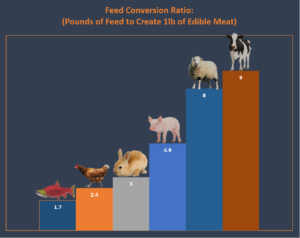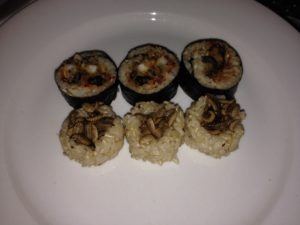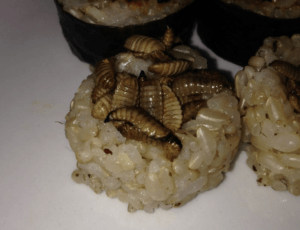Marine Harvest ASA – The $8 billion company you’ve never heard of

Climate change could make your lox and bagels a lot more expensive.

Source: Data from Yahoo! Finance.[i] Graph created in Excel.
Even though you’ve probably never heard of Marine Harvest, you’ve very likely tasted its products. Based in Norway, Marine Harvest (“MH”) is an aquaculture (aka fish farming) company that commands 30% of the global salmon and trout market, the largest share in the world.[ii] Recently, company management has begun to address the pressing issues that climate change poses to its business.
In its most recent 20-F filing with the SEC, MH cites “rising ocean temperatures and ocean acidification” as “the two main threats” that climate change poses to its ongoing business operations.[iii] Additionally, the company faces external threats from price fluctuations in the raw materials of fish feed, which currently accounts for nearly half of COGS.[iv],[v] This risk must be mitigated to ensure consistent future production and avoid future price increases that will be passed to the end consumer. As a New Yorker, I already pay $15 for lox and bagels… I’m not sure I’m willing to pay much more.
Why is this important? – global perspective

Source: Data from PeakProsperity.com.[vi] Chart created in Excel.
It’s important to note that climate change will likely necessitate a shift in the proteins humans consume. This is evidenced by the feed conversion ratios above. As you can see, the feed conversion ratio of farmed salmon is vastly superior to that of alternative protein sources. Currently, water covers 70% of the Earth’s surface, but only 2% of our calories are derived from the water.[vii] It’s likely that our society will shift to a more heavily fish-based diet in the future, and MH’s issues are therefore imperative to solve.
Marine Harvest’s plan – is it enough?
In response to climate threats, MH has implemented a campaign titled the “Blue Revolution.” Under this plan, MH will invest in R&D to improve fish genetics and harvest efficiency. The company also will invest in state-of-the-art fish feed production facilities.[viii]
But this is hardly a “revolution,” and I don’t believe it will be enough to counteract the increasingly deleterious effects of climate change on our oceans. MH needs to take the movement further by ending dependence on the ocean, the climate, and traditional feed sources altogether.
What I would do – the part you’ve been waiting for!
Invest in climate-agnostic farming techniques:
Although there are a few alternative methods, aquaponics is, in my opinion, the best option. Aquaponics combines fish and produce farming. Nutrients generated by broken-down fish waste are consumed by plants, and the resulting clean water circulates back to the fish. Aquaponics uses 90% less water than traditional farming and requires zero artificial fertilizers or chemical pesticides. From a business perspective, the technology is especially enticing due to its extensive use of low-cost materials, such as PVC piping and plastic drums. With aquaponics, MH could grow duckweed and other high-protein plant materials to supplement the salmon and trout feed–all while using fish waste as fertilizer! Additionally, the isolated fish tanks would ameliorate the serious issues of disease and bacteria outbreaks.[ix]
For now, aquaponics would coexist with MH’s existing ocean operations. The alternate sources of production would diversify the company’s processes and hedge the effects of unpredictable weather and other variables that would otherwise destroy a year’s harvest.
Invest in more efficient protein sources:
As mentioned earlier, the price of fish meal fluctuates wildly as the changing climate affects crop yields. I propose that MH begin to cultivate black soldier fly larvae (“BSFL”) to feed its hungry fish. BSFL will eat nearly anything and are among the most efficient protein-producers on the planet. In fact, a 2005 study out of the University of Georgia and NC State University definitively concluded that BSFL who ate pig manure vastly increased nutrient concentrations and showed extreme promise as animal feed, “particularly for aquaculture.”[x]
As a side note, BSFL have already caught on in certain places—even for human consumption! This is a snack I recently enjoyed at Miya’s Sushi in New Haven, CT:

Look closer:
To be honest, they were pretty flavorless (a little salty) and not something I think will be on restaurant menus any time soon. But I do think BSFL will be what our food eats.
Concluding thoughts – MH’s issues aren’t unique
Aquaculture is just one industry among many that climate change will adversely affect. And while Marine Harvest is making an industry-leading push to prepare for what’s coming, I’m still not sure it will be enough to weather the storm.
(743 words)
Sources:
[i] Yahoo! Finance, “Marine Harvest ASA (MHG.OL)”, https://finance.yahoo.com/quote/MHG.OL/history?p=MHG.OL, accessed November 2016.
[ii] Marine Harvest ASA, December 31, 2014 Integrated Annual Report, page 34, http://www.marineharvest.com/investor/annual-reports/, accessed November 2016.
[iii] Marine Harvest ASA, December 31, 2015 Form 20-F, page 38, http://www.marineharvest.com/investor/annual-reports/, accessed November 2016.
[iv] Marine Harvest ASA, December 31, 2015 Integrated Annual Report, page 42, http://www.marineharvest.com/investor/annual-reports/, accessed November 2016.
[v] Marine Harvest ASA, December 31, 2015 Integrated Annual Report, page 24, http://www.marineharvest.com/investor/annual-reports/, accessed November 2016.
[vi] Peak Prosperity, “Can You Feed Your Family With Aquaponics?”, https://www.peakprosperity.com/forum/can-you-feed-your-family-aquaponics/42669, accessed November 2016.
[vii] Marine Harvest ASA, “Marine Harvest Leading the Blue Revolution,” http://www.marineharvest.com/planet/the-blue-revolution/, accessed November 2016.
[viii] Marine Harvest ASA, “Marine Harvest Leading the Blue Revolution,” http://www.marineharvest.com/planet/the-blue-revolution/, accessed November 2016.
[ix] Marine Harvest ASA, December 31, 2015 Integrated Annual Report, page 26, http://www.marineharvest.com/investor/annual-reports/, accessed November 2016.
[x] Entomology Today, “Black Soldier Flies as Recyclers of Waste and Possible Livestock Feed,” https://entomologytoday.org/2015/05/26/black-soldier-flies-as-recyclers-of-waste-and-possible-livestock-feed/, accessed November 2016.




This blog post seems to suggest that farmed fishing needs to change in order to stay profitable. However, in many ways, it appears global warming is making farmed fishing more profitable. First off, as you point out, the feed conversion ratios for salmon are lower than any other form of meat. As it becomes increasingly difficult to produce other forms of protein, fish will become relatively more cost effective. Furthermore, global warming and the increasing affects of el nino are leading to more unstable wild fish stocks, making farmed salmon even more appealing. While aquaponics may make sense, I do not see there being enough pressure on farmed fishermen to change their practice drastically.
Thanks for the comment, Andrew.
To respond: the farmed salmon in question are currently raised in the same bodies of water as the wild salmon stocks, and they are therefore subject to the same “increasing effects of el nino” that you mention above. My point is that neither wild salmon nor farmed salmon (as they are currently raised) are sustainable in the long-run, and in the future only farmed salmon raised in controllable environments can be relied upon as a food source.
Very interesting post, and while yes, climate change has impacted fish farming, I agree with Andrew’s point above that not enough of a disruption has occurred such that farmed fisherman are making any clear changes in their processes. One alternative, however, is to move farmed fisherman into a new area of salmon: GMO salmon or otherwise known as “Franken Fish.” Last year, the FDA approved the sale of GMO salmon, specifically developed by AquaAdvantage; it was the first altered animal cleared for human consumption in the United States. This version of the fish grows twice as fast as normal salmon, which has the potentially to change the landscape of the salmon industry forever by significantly increasing salmon supply in the market. By increasing supply and driving down salmon prices, GMO salmon could essentially force farmed fisherman to resort to either farming GMO salmon or getting out of the business completely. If the latter happens, there could be a substantial decrease fish farming altogether, thereby eliminating the climate change issue. In addition, the GMO salmon are created in labs, which one could argue, use less environmental resources and is better for society. We can only wait to see whether the next lox bagel we eat actually has GMO salmon on it or not.
Source: http://www.nypost.com/2015/11/20/frankenfish-salmon-coming-soon-to-a-supermarket-near-you/
Very insightful comment, ABCD. Thank you.
I mentioned genetically modified salmon as part of Marine Harvest’s plan to “invest in R&D to improve fish genetics.” I really don’t think it’s a question of whether Frankenfish will hit our plates (or, most importantly, our bagels!) soon… the question is when ALL fish we consume will be Frankenfish.
And when GMO salmon “are created in labs” as you mention in your post, it’s important to note that these “labs” will look just like an aquaculture farm. Whether farmed salmon reach harvestable maturity in 3 years or 1 year does not change the fact that they must be sustainably raised in tanks of water.
Interesting post, it definitely seems like aquaculture is the wave of the future for fish consumption and yet even within this disruptive industry climate change is creating a real need for change. One consideration I’d love to get your thoughts on is how aquaculture can be applied to different types of fish. While many other farmed proteins–beef, chicken, pork–generally source from one species and so can use much more universal techniques for feeding and growing, fish comes from a plethora of different species that each have their own supply and demand. Just looking at a typical sushi menu, you see tuna, salmon, shrimp, eel… and even within tuna you have bluefin tuna, yellowfin tuna, and many other types of animals.
My question is, how can we and Marine Harvest balance the need to shift to sustainable aquaculture with the highly variable demands of the many different species of fish that people demand? I see that as one of the underlying causes for Marine Harvest’s current reliance on fish meal feed and ocean pools–some fish just cannot grow without these factors. One example that I found was bluefin tuna, which is Japan’s fish of choice and which is also notoriously fickle in aquaculture conditions. I fear that such bespoke tastes will limit the ability of aquaculture firms like Marine Harvest to be as sustainable as possible.
Source: http://www.economist.com/news/asia/21707570-fish-farming-latest-slim-hope-japans-favourite-fish-breeding-bluefin
King, you’ve just raised one of the most pressing issues in the effort to create more sustainable food sources: the human desire for variety. Unfortunately, I believe that we will have to make some sacrifices in the quest for more environmentally friendly protein production, and we will see some big changes in the lineup of fish that we commonly consume.
While many fish varieties will remain accessible, the choice of what to eat will become an economic one: commonly farmed fish species will be cheap, and rare species will be expensive. You’ve already started to see this happen in grocery stores… haven’t you wondered why every grocery store seems to be hawking giant bags of tilapia? That’s because they’re super easy and cheap to farm!
On a similar note, the economics of fish farming will likely lead to increased consumption of fish that are relatively uncommon on our plates today; for example, I’d guess that the Silver Perch (very temperature insensitive), Trout (reach maturity in 6 months), and Pacu (will eat anything) are just a few years away from being ubiquitous on restaurant menus.
And to directly respond to your worry about bluefin tuna… they aren’t going anywhere. But you can bet that that delicious slice of sashimi will be a hefty line-item on your check.
P.S. Google Image search the “Pacu” fish that I mentioned above. In particular, take a look at its teeth.
Thanks for the thoughtful reply! Fair point on good ol’ supply and demand fixing the problem, I’m guessing restaurants may continue to value variety but the bulk of consumption from consumers will shift to reflect pricing signals.
As for the Pacu, that is a weird looking fish, thanks for the find I think…
This is after the time period but I thought I would pose a question… Do you think that the massive difference in the input ratios for the feeds relate more to the quality of the feed than the inherent efficiency of the animal in producing edible meat? I know that salmon are typically fed high-calorie fishmeal which is composed of herring, anchovies, sardines while cows are fed low calorie foods like hay. Do you know if any work has been done on the carbon footprints of these feedstocks?
Hi Michael, thanks for the question.
Lots of research has been done on the carbon footprints of feeding various types of livestock, and cow diets unequivocally come out on the bottom while fish diets come out on top. Cows also pose a double threat to the environment, as their vegetarian diets make them so gassy that their flatulence is responsible for over a quarter of global methane emissions each year… and as we saw in our EcoSecurities case, methane is much worse for the environment than CO2. Also, in contrast to what you posit above, farmed salmon are generally fed a mix of soy, wheat, corn, beans, and vegetable oil (i.e. rapeseed or sunflower) and not herring, anchovies, or sardines.
Nevertheless, you’re probably still wondering what could possibly lead to such a startling disparity in feed conversion ratios between cows and fish. One interesting reason for the difference is that land animals must combat gravity in their daily lives, which leads to a lower percentage of energy available for muscle conversion. Fish, on the other hand, benefit from their natural buoyancy within the water.